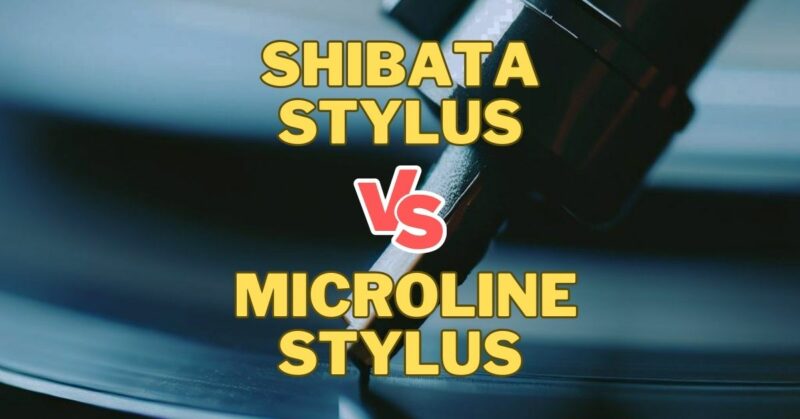When it comes to vinyl playback, the stylus is arguably the most critical component. It is responsible for the conversion of the mechanical energy in the record groove into an electrical signal that can be amplified and sent to your speakers. As such, choosing the right stylus can significantly impact the sound quality of your vinyl collection. Two popular stylus options are the Shibata and the Microline, which are known for their high fidelity and precision. In this article, we’ll explore the differences between these two types of stylus, their respective strengths and weaknesses, and how they affect the overall sound quality of your vinyl playback.
Shibata Stylus
The Shibata stylus was first introduced in the early 1970s by JVC, and it quickly became popular among audiophiles for its high tracking ability and frequency response. The Shibata stylus features a diamond-shaped tip that is angled at 23 degrees, which allows it to track the groove walls with greater accuracy and depth than other stylus types. This improved tracking ability also reduces distortion and surface noise, resulting in a cleaner, more detailed sound.
One of the advantages of the Shibata stylus is its ability to extract high frequencies from the record groove. Due to its diamond shape, it can access more of the groove wall, which allows it to pick up more high-frequency information than other stylus types. As a result, the Shibata stylus is ideal for playing high-quality, high-frequency recordings such as classical music or jazz.
However, the Shibata stylus is also known for its relatively high tracking force. This means that the stylus exerts more pressure on the record groove, which can lead to increased record wear and tear over time. It is also more prone to skipping if the record is warped or damaged.
Microline Stylus
The Microline stylus is a type of elliptical stylus that features a finer diamond tip than other elliptical stylus types. It is similar to the Shibata stylus in terms of its accuracy and ability to extract high-frequency information from the record groove. However, the Microline stylus is designed with a smaller contact area, which reduces record wear and tear and allows for a lower tracking force.
One of the advantages of the Microline stylus is its ability to track the record groove more precisely than other elliptical stylus types. Its smaller contact area allows it to track the groove with greater accuracy and depth, resulting in a cleaner, more detailed sound. It is also less prone to skipping than other stylus types, making it ideal for playing warped or damaged records.
However, the Microline stylus is also more sensitive to dirt and dust than other stylus types. Because of its fine diamond tip, it can be easily damaged by debris in the record groove, which can lead to reduced sound quality and increased record wear and tear.
Comparing Shibata and Microline Stylus
When comparing the Shibata and Microline stylus, it’s important to consider your specific needs and preferences. Both stylus types are known for their accuracy and ability to extract high-frequency information from the record groove. However, there are some key differences that may impact your decision.
One of the main differences between the Shibata and Microline stylus is their tracking force. The Shibata stylus requires a higher tracking force than the Microline stylus, which can lead to increased record wear and tear over time. If you plan on playing a lot of records, especially older or more fragile records, you may want to consider a Microline stylus to reduce the risk of record damage.
On the other hand, the Shibata stylus may be a better choice if you primarily listen to high-quality, high-frequency recordings such as classical music or jazz. The Shibata
stylus is known for its ability to extract more high-frequency information from the record groove, which can result in a more detailed and accurate sound. If you are an audiophile looking for the highest possible fidelity from your vinyl collection, the Shibata stylus may be the better choice.
Another consideration when choosing between the Shibata and Microline stylus is the condition of your records. If you have a large collection of older, warped, or damaged records, the Microline stylus may be the better choice. Its smaller contact area and lower tracking force make it less prone to skipping and can help preserve your records over time. However, if your records are in good condition and you want to extract as much detail and accuracy as possible from the grooves, the Shibata stylus may be a better choice.
Conclusion
Ultimately, the decision between the Shibata and Microline stylus will come down to your personal preferences and listening habits. Both stylus types are capable of delivering high-quality sound, and choosing the right one for your system will depend on a variety of factors.
It’s also worth noting that there are other stylus types available, each with their own strengths and weaknesses. For example, the line contact stylus is another popular option that is known for its accuracy and ability to track the record groove with precision. The conical stylus is another common option that is known for its durability and ability to play older or worn records.
In conclusion, the Shibata and Microline stylus are two popular options for vinyl enthusiasts looking for high-fidelity sound reproduction. While both stylus types are capable of delivering excellent sound quality, there are some key differences to consider when choosing between them. Whether you choose the Shibata or Microline stylus, it’s important to select a high-quality stylus that is well-suited to your specific needs and listening habits. By doing so, you can enjoy the best possible sound quality from your vinyl collection and ensure that your records are well-preserved for years to come.

